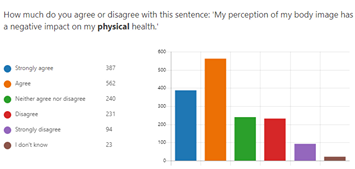“FASHION HAS THE POWER TO GLORIFY BODIES & IDENTITIES, TO INCLUDE THEM IN A NARRATIVE OF LUXURY AND BEAUTY”
– HARI NEF, TRANSGENDER MODEL
The Burden of Under-Representation
Research emphasized how underrepresentation in the fashion industry creates a burden on women,measuring their self-worth with the ideal standards of beauty. This burden is further exacerbated forwomen from diverse ethnic, racial, or cultural backgrounds, as well as women across various agegroups, socioeconomic classes, and physical abilities, among others.
Social values are shaping purchase decisions more than ever—and retailers that act now are likely toattract consumers’ loyalty and spending. The consumer is becoming more inclusive every day.
However, the fashion industry continues to face challenges in adopting an inclusive approach towardsthe end-consumer. The majority of images in photoshoots, marketing campaigns, and communicationstill predominantly feature “standard” models (1.76m tall, size 36, with a rectangular body type).

A conducted survey found that 80% of respondents agreed or strongly agreed that their body imagehad a negative impact on their mental health, with 61% agreeing or strongly agreeing that their body image negatively impacts their physical health.
Recent research has highlighted significant shifts in how individuals perceive and feel about their bodies, as well as the actions they undertake to pursue perceived improvements. The emergence of social media and rise in online advertising have both increased exposure to certain idealised body types.
This obviously calls for some shifts in the fashion industry, in order to address these issues properly.
The Need for an Inclusive shift
In the post-COVID era, an increasing number of individuals are gravitating towards online clothing shopping. The prominent factors driving this shift include efficiency and comfort. However, given the extensive array of clothing options available online without proper curation, customers often face challenges in finding items that align with their body type and preferences, leading to a sense of overwhelm.
The rise of the inclusive consumer is reshaping the priorities for the retail industry. The evidence overwhelmingly suggests that inclusive consumers are at the forefront, influencing consumers across various demographic segments and making purchasing decisions that support retailers who champion diverse entrepreneurs and their products.
In the post-COVID era, an increasing number of individuals are gravitating towards online clothing shopping. The prominent factors driving this shift include efficiency and comfort. However, given the extensive array of clothing options available online without proper curation, customers often face challenges in finding items that align with their body type and preferences, leading to a sense of overwhelm.
Consumers have been taught to shop by trend and by size. But these habits show 1 important flaw: the shape of the body is not being taken into account.

The body shape plays a crucial role in determining how a garment appears on an individual. Not every trend is universally flattering for every body shape, and even the correct size may not always enhance one’s appearance.
In addition, the clothing industry does not follow a single measurement system resulting in size inconsistencies between brands. These factors can lead to confusion for buyers, often resulting in the return of products that fail to meet their expectations. As a consequence, many individuals experience post-purchase disappointments when they realize the product does not live up to their desired appearance in the mirror.
While consumers typically consider their skin tone or type when purchasing cosmetic or skincare products, a similar approach is often lacking when it comes to shopping for clothing. It would be beneficial for consumers to start their clothing shopping journey by considering their own selves, features, and preferences, making conscious choices. This shift in approach can have a positive impacton body positivity and relieve the hassles associated with returns. Furthermore, it is essential to recognize that aside from being highly inefficient, returns also contribute significantly to pollution, posing an escalating threat to our planet with each passing day.
New Technologies to the rescue
For a significant period, the fashion industry has grappled with under-representation and exclusion.However, consumers have been actively challenging this longstanding status quo in notable ways overthe past year, much like their efforts to address other outdated practices within the industry.
Fashion brands, especially big houses, have historically favored models and consumers withEurocentric beauty standards, leading to a very particular sizing, design, and consumer base.Consumers have had enough. The industry is becoming more diverse and inclusive thanks to:

- The advent of social media
- The use of different ages, ethnicity & bodytypes
- New technologies
- Changing consumer values
Fashion technologies are experiencing a significant surge in popularity. Among these advancements, shopping tools stand out as a prime example. These tools, designed to personalize the shopper’s journey, can provide invaluable assistance in overcoming the challenges consumers face when seeking clothing that suits their unique preferences and body type.
Contour Lab’s software has been specifically developed to address this need. By asking users straightforward and uncomplicated questions, the software accurately identifies their body type, subsequently generating a personalized shopping page. This page presents tailored recommendationsfor clothing items that are most flattering to the individual. Through the utilization of data intelligence, retailers are able to gain insights into their online customers and enhance their shopping experience. As a result, consumers can make more informed and successful choices, promoting conscious shopping practices.
Sources:
“A CALL FOR DIVERSITY AND INCLUSION: EXAMINING FASHION EXPERIENCES OF MINORITY WOMEN”, by Lena Cavusoglu & Deniz Atik (https://www.researchgate.net)
“The impact of body image on mental and physical health”, by the Health and Social Care Committee of UK Parliament (https://publications.parliament.uk/pa/cm5803/cmselect/cmhealth/114/report.html )
“State of Fashion- Technology Report 2022 ,by Anita Balchandani, Achim Berg, Holger Harreis, Carlos Sanchez Altable, Roger Roberts, Saga af Petersens & Imran Amed (https://www.mckinsey.com/industries/retail/our-insights/state-of-fashion-technology-report-2022)
” The Rise of the Inclusive Consumer”, by Pamela Brown & Tiffany Burns (https://www.mckinsey.com/industries/retail/our-insights/the-rise-of-the-inclusive-consumer)
“Innovation in a crisis- why it is more critital than ever, by Jordan Bar Am, Felicitas Jorge, Laura Furstenthal & Erik Roth. (https://www.mckinsey.com/capabilities/strategy-and-corporate-finance/our-insights/innovation-in-a-crisis-why-it-is-more-critical-than-ever)
